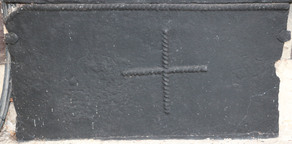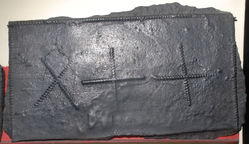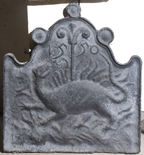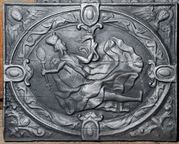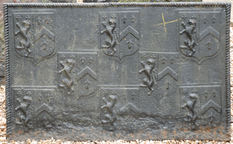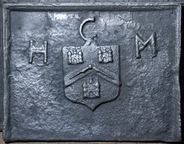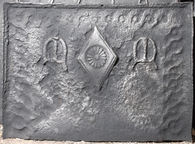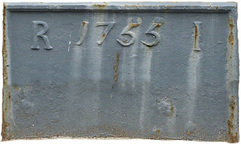-
1115
Description: Fragment; canted rectangular; twisted rope edging (topand sides); central cross of twisted rope.
Notes: Sections missing at both ends.
- Decoration tags:
- rectangular with canted top corners (shape)
- rope (edging)
- simple stamps
- apotropaic
- objects
Manufactured: in the 16th century in the Weald area of England.
Current location: in private hands, Crowborough, East Sussex, England.
- Attached to series:
- Rope design firebacks
-
169
Description: Rectangular; twisted rope edging (top and sides); inscription made of short lengths of twisted rope, irregularly spaced across upper middle, central device formed of a Tudor 'A' with overstamped 'V'.
Notes: It is not clear if the central device is a monogram, or if it might have apotropaic significance.
Inscription: T A M T
- Decoration tags:
- rectangular (shape)
- rope (edging)
- simple stamps
- apotropaic
- text
- objects
Manufactured: in the early- to mid-16th century in the Weald area of England.
Current location: Hastings Museum and Art Gallery, John's Place, Bohemia Road, Hastings, East Sussex, England.
Museum number: HASMG: 1911.60.7 (part of the Hastings Museum museum group)
Citation: Page, S. & Wallace, M. (eds.), 2018, Spellbound (Oxford, Ashmolean Museum), p. 72.
- Attached to series:
- Rope design firebacks
-
374
Description: Quasi-rectangular; twisted rope edging (top and sides); a length of twisted rope stamped six times to form a saltire and two crosses across the width of the plate; surplus iron extends from all sides.
Notes: The surplus iron resulted from over filling of the mould. The crosses are likely to have Christian significance. Formerly part of the J. H. Every collection.
- Decoration tags:
- rectangular (shape)
- rope (edging)
- simple stamps
- apotropaic
- objects
Manufactured: in the mid- to late-16th century in the Weald area of England.
Current location: Anne of Cleves House, Southover High Street, Lewes, East Sussex, England.
Museum number: 1944.24.037 (part of the Sussex Archaeological Society museum group)
Citation: Hughes, G. B., May 1940, 'Old English Firebacks', Apollo, 31, 185, pp. 117-120.
- Attached to series:
- Rope design firebacks
-
407
Description: Quasi-arched rectangular shaped; unique, cavetto moulded edging, which loops upon itself three times. A mythical salamander shown in the flames which legend states it is able to resist; behind is what appears to be a palm tree, on either side of which the date is stamped.
Notes: The fireback has been incorrectly dated 1550 instead of 1650, which Schubert, following W. R. Lethaby, asserted was a forgery claiming indications that a ‘6’ had been erased. Undoubtedly the first '5' is more prominent than the other figures though the exact method by which it has been substituted is not clear. Corrosion to the bottom right corner may have obliterated a letter 'M' seen on another casting; presumably part of 'IM'.
Inscription: 1550
- Decoration tags:
- rectangular with ornate arch (shape)
- cavetto (edging)
- whole carved pattern
- individual numbers
- pictorial
- mythological
- text
- animals
Manufactured: in 1650 possibly at Brede Furnace in the Weald area of England.
Current location: Anne of Cleves House, Southover High Street, Lewes, East Sussex, England.
Museum number: LH000.901 (part of the Sussex Archaeological Society museum group)
Citation: Dawson, C., 1903, 'Sussex Iron Work and Pottery', Sussex Archaeological Collections, 46, pp. 1-54.
Citation: Gardner, J. S., 1898, 'Iron Casting in the Weald', Archaeologia, 56, 1, pp. 133-164.
Citation: Lethaby, W. R., 1 Oct 1926, 'English Cast Iron - I', The Builder, 131, no. 4365, pp. 537-8.
Citation: Schubert, H. R., 1957, 'A Forgery in Iron', Journal of the Iron & Steel Institute, 165, p. 125.
- Attached to series:
- Hooked '1' series
- Loop edged firebacks
- Brede group
-
598
Description: Rectangular with fillet edging; central, oval panel with fillet edging containing the semi-reclining, begowned figure of Cleopatra, a mirror/sceptre in her right hand and an asp in her left hand; oval border with astragal and fillet edging and undulating foliage; in each of the top spandrels, a face of a putto; in the bottom spandrels, a triangular design of swirled foliage; at the centre of each side, overlapping the central oval border, an oval cartouche with scrolls in the inward facing side; four horizontal plank lines regularly spaced.
Notes: The naivety of the figuration and the similarity of the scrolled designs suggest that this may be the work of the same pattern-maker as the Lenard fireback. Three tapestries of the death of Cleopatra, one of them made for the Swedish royal court, were inspired by artwork by Karel van Mander II (1579-1623), which is likely to have been the inspiration for this fireback as well.
- Decoration tags:
- rectangular (shape)
- fillet (edging)
- whole carved pattern
- planklines
- pictorial
- historical
- humans
Manufactured: in the mid-17th century in the Weald area of England.
Current location: Mark Ripley Forge & Fireplaces, Northbridge Street, Robertsbridge, East Sussex, England.
- Attached to series:
- Brede group
-
607
Description: Rectangular; twisted rope edging (top and sides only); eight shields of Ayloffe impaling Sulyard in three rows, 3-2-3; Ayloffe: sable, a lion rampant Or, collared gules, between three crosses formy of the second; Sulyard: argent, a chevron gules between three pheons inverted sable.
Notes: William Ayloffe (c1535-1584) of Bretons, Hornchurch, Essex, Justice of the Court of Queen’s Bench, married (c1560) Jane, dau. of Sir Eustace Sulyard, of Runwell, Essex.
Arms: Ayloffe impaling Sulyard (William Ayloffe of Bretons, Hornchurch)
- Decoration tags:
- rectangular (shape)
- rope (edging)
- carved stamps
- armorial
Manufactured: in the early-17th century in the Weald area of England.
Current location: Mark Ripley Forge & Fireplaces, Northbridge Street, Robertsbridge, East Sussex, England.
- Attached to series:
- Ayloffe series
- Personal armorial firebacks
-
608
Description: Rectangular; ovolo-moulded edging (top and sides); shield of the Worshipful Company of Masons: Sable, on a chevron, engrailed argent between 3 castles of the second, with doors and windows of the field, a pair of compasses extended of the first; above, the letter ‘C’, the letters ‘H’ and ‘M’ split by the shield.
Notes: The arms of the Masons’ Company were granted in 1473. Sold at Christie's Masters and Maker auction, 30 November 2010, lot 523 (£500).
Copies of this fireback are known.
Inscription: HCM [triad]
Arms: Worshipful Company of Masons
- Decoration tags:
- rectangular (shape)
- ovolo (edging)
- carved stamps
- individual letters
- armorial
- text
Manufactured: in the early-17th century possibly in the Weald area of England.
Current location: not known.
- Attached to series:
- Livery company firebacks
-
640
Description: Rectangular; ovolo-moulded edging (top and sides); repeated guilloche pattern inside top and side edges; upper centre, lozenge stamp with ovolo edges and recessed daisy flower in centre, between buckle stamps repeated twice.
Notes: The lozenge stamp is a design also seen on domestic interior panelling; the buckles suggest a Pelham family association; the buckle and lozenge are separate stamps, and in each example their relative positions differ slightly; the guilloche design appears to have been carved on the base panel; an example at The Star Inn, Alfriston, Sussex measures 665mm x 480mm.
- Decoration tags:
- rectangular (shape)
- ovolo (edging)
- carved stamps
- carved pattern panels
- heraldic
- objects
Manufactured: in the early- to mid-17th century in the Weald area of England.
Current location: Mark Ripley Forge & Fireplaces, Northbridge Street, Robertsbridge, East Sussex, England.
- Attached to series:
- Pelham family firebacks
- Pelham buckle and lozenge series
- Metalware stamp firebacks
-
675
Description: Quasi-arched rectangular shape; fillet edging; centre, fluted flower vase containing a variety of flowers, with a plant growing on each side, all within an arched rectangular bead-and-pellet border with looped top corners; on each side, a festoon of bell flowers, with a putto blowing a trumpet above; over each of their heads a single rose; top centre, a sunburst; bottom, an animal’s face between mirrored swirled foliage.
Notes: One of a small group of firebacks with similar outlines.
Copies of this fireback are known.
Manufactured: in the early- to mid-18th century in England.
Current location: Saffron Walden Museum, Saffron Walden, Essex, England.
Museum number: 1897-03 (part of the Saffron Walden Museum museum group)
- Attached to series:
- Late pictorial series (all)
- Late pictorial series 6
-
1287
Description: Rectangular shape; ovolo-moulded edging; top centre, date between split initials.
Notes: The letters and numerals are particularly well formed. The fireback is displayed out of doors against a wall at the side of the street and the lower part is recessed into the pavement.
Inscription: R 1755 I
- Decoration tags:
- rectangular (shape)
- ovolo (edging)
- carved stamps
- individual letters
- individual numbers
- text
Manufactured: in 1755 possibly in the Weald area of England.
Current location: 15-17 High Street, Seaford, East Sussex, England.
- Attached to series:
- Date & initials firebacks
